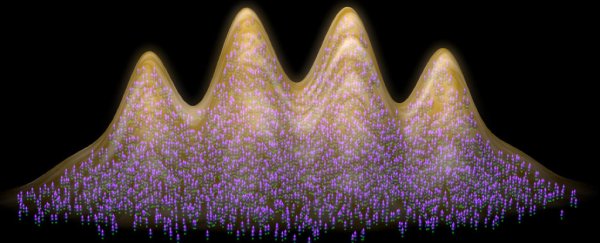Scientists have observed the clearest evidence yet of an incredibly rare and exotic theoretical phase of matter called a supersolid – and while it only lasted experimentally for a fleeting instant in the lab, it's the longest we've ever glimpsed such paradoxical strangeness to exist at all.
Supersolids were first theoretically predicted to exist a half-century ago, fusing both the rigid characteristics of solids and the flowing characteristics of liquids at the atomic level.
What this means is that somehow, as impossible as it sounds, the atoms that make up these strange supersolid materials are spatially arranged in such a way that they resemble a crystalline structure, while simultaneously embodying the liquid-like properties of superfluidity.
Scientists have been studying supersolid matter for decades, both theoretically but also experimentally, trying to replicate and somehow observe them in the real world, mostly in experiments with an isotope of helium called superfluid helium-4.
However, despite many attempts – including a purported breakthrough in 2004 – firm proof for a helium-based supersolid still remains elusive.
But there's another way of potentially tricking supersolids into existence, with more recent attempts centred around ultra-cold quantum gases such as Bose–Einstein condensates (BECs). In these condensates, particles that make up the gas become so cold, they begin to show supersolid behaviour.
"Recent experiments have revealed that such gases exhibit fundamental similarities with superfluid helium," says experimental physicist Lauriane Chomaz from the University of Innsbruck in Austria, the first author of a new paper on this research.
"These features lay the groundwork for reaching a state where the several tens of thousands of particles of the gas spontaneously organise in a self-determined crystalline structure while sharing the same macroscopic wavefunction – hallmarks of supersolidity."
In the new experiments, Chomaz and fellow researchers worked with two such quantum gases, producing BECs of isotopes of erbium (erbium-166) and dysprosium (dysprosium-164).
Both of these gases are remarkable for featuring strong dipolar interactions, which, when tweaked sufficiently by ultra-cold temperatures, promotes atomic grouping into 'droplet' formations that themselves promote supersolidity.
"For several years, researchers have known these BECs have the ingredients for supersolidity," quantum researcher Tobias Donner from ETH Zurich, who wasn't involved with the study, explains in a Physics overview piece.
"First, they are superfluids. And second, under certain conditions, the atoms will segregate into several dense droplets, providing the necessary density modulation."
Although erbium-166 and dysprosium-164 are both good candidates for inducing supersolid behaviour, the team's results showed the two gases are not equal.
In the experiments with the erbium isotope, the supersolid state observed was "only transient", senior researcher Francesca Ferlaino explains; in contrast, the dysprosium BEC demonstrated "unprecedented stability" for a supersolid.
"Reaching the phases via a slow interaction tuning, starting from a stable condensate, we observe that erbium-166 and dysprosium-164 exhibit a striking difference in the lifetime of the supersolid properties, due to the different atom loss rates in the two systems," the authors write in their paper.
"Indeed, while in erbium-166 the supersolid behaviour survives only a few tens of milliseconds, we observe coherent density modulations for more than 150 ms in dysprosium-164."
Of course, 150 milliseconds might not seem very long to you and me, but for an incredibly exotic and quasi-impossible phase of matter that has to be coaxed into existence to be seen at all, it's actually "remarkably long-lived", to quote the research team.
Despite that long life, the researchers stop short of proclaiming these results offer the unambiguous proof of supersolidity we've been looking for, describing the work as "evidence for hallmarks of this exotic state in ultracold dilute atomic gases".
That said, it's clear we're edging ever closer to even more exciting breakthroughs, especially since this research follows close on the heels of two other very recent experiments honing in on supersolid states in dipolar quantum gases.
For solid proof of the supersolid, it may only be a matter of time.
The findings are reported in Physical Review X.
